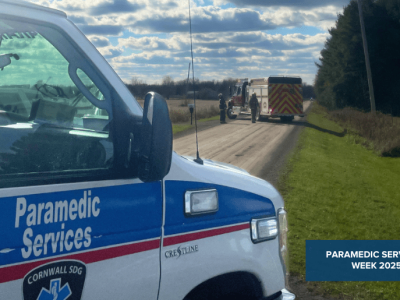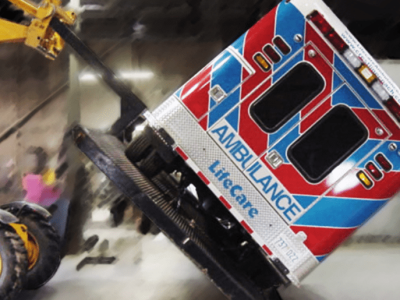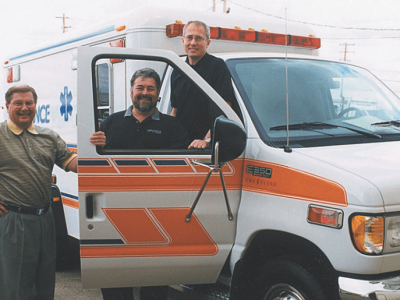A Milestone Built Together
A business is more than its products or services; it’s the people behind it who drive it forward. As Crestline marks its 50th anniversary, this milestone is not just about years in operation; it’s about the relationships that shaped every step of the journey.
For five decades, the trust, support, and collaboration of our customers have been the foundation of our success. From our early days in Saskatoon to the communities we now serve across Canada and beyond, one thing has always remained true: our customers made us who we are.
Every milestone we’ve achieved, from the first ambulance we delivered, to the thousands now on the road, has been driven by the needs, feedback, and support of those we serve.
This anniversary isn’t just ours. It belongs to every paramedic service, transportation provider, municipal leader, and health partner who chose to believe in our team and our mission.
Where it all began: The people and partners behind Crestline’s growth

After gaining firsthand experience through Crescent Ambulance Services, Peter Adsten, Ken Sawatsky, and Ronn Janzen recognized the need for ambulances that better supported both patient care and paramedics on the road. On April 28, 1975, they founded Crestline Coach Ltd. with a mission to design and manufacture ambulances that would meet the needs of customers and paramedics across Canada. This commitment continues to guide Crestline today.
1975 – Shamrock Ambulance Care, Wadena, SK
This is a 1975 Dodge Low Roof Crescent Type II ambulance.
This ambulance was built for two of our Crescent Ambulance Service employees, Brian Erickson and Rick Reddekopp, who had purchased Narfason’s Ambulance Service in Wadena SK and were operating under a new name, Shamrock Ambulance Care.

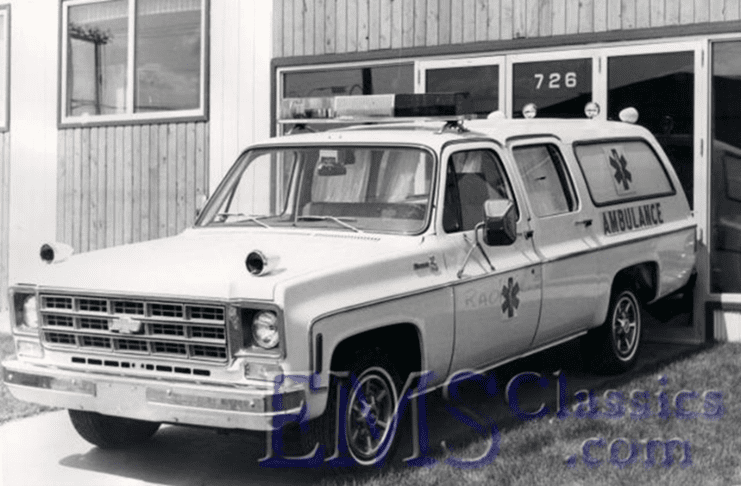
1977 – Mayerthorpe, AB
GM Suburban Crestline Ambulance, sold to Don Schuler of Mayerthorpe, AB.
1979 – Saint Rose, MB
Saint Rose, Manitoba purchased Crestline’s 100th vehicle, a Ford ambulance. It was used as a demonstrator and traveled to ambulance services throughout Saskatchewan, Manitoba, and Alberta. Thanks to this vehicle, Crestline had the opportunity to meet directly with paramedics, ambulance operators, and hospital administrators across the Prairies. These conversations offered valuable insights in patient access, storage design, and crew ergonomics. This moment reinforced how essential customer feedback is to the evolution of every Crestline vehicle.


1980 – Alberta Power, AB
After an accident at Alberta Power’s Grande Cache site, their on-site ambulance failed, causing a delay in emergency care. The workers made it clear they would not return to the job site until a proper ambulance was in place. That Friday, Alberta Power called Crestline for help.
The team quickly sourced a GM van and got to work over the weekend, converting it into a fully equipped industrial ambulance. By Sunday night, it was ready to go. Moments like this reinforced how important it is for Crestline to be there when our customers need us most.
1980 – City of Winnipeg
These are the first modular ambulances sold to the City of Winnipeg, MB and Parkland Ambulance, SK.
Here we see Peter Adsten handing the keys over to Barry and Wayne Dutchak.

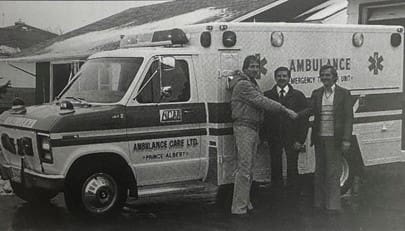
Late 70’s to mid-1980's
Crestline produced a number of Limousines and Funeral Coaches as a means of diversifying their product lines. Traditionally ambulance manufacturing companies also produced funeral vehicles.

1980 - The Rosetown Hospital
This is the first purpose built wheelchair-accessible van for the Rosetown Hospital.
1981 – Edmonton Ambulance Authority, Alberta
When the Edmonton Ambulance Authority, in collaboration with the University of Alberta Hospital, approached Crestline with a request for a custom neonatal ambulance, the challenge was clear. They needed a vehicle capable of handling long-distance transfers with space for two transport incubators, seating for multiple medical professionals, and a highly advanced electrical system to support critical care.
Crestline worked closely with the customer to understand every detail of the mission. The result was a unit featuring dual alternators generating 250 amps, two 1600-watt generators, and four 250-amp storage batteries. It also included three fuel tanks to extend run time in remote areas. In the event of a vehicle failure, the system could continue powering incubators and life-saving equipment for up to six hours.
This project was more than a technical achievement. It was a powerful example of how customer needs challenge Crestline to think differently, solve complex problems, and continue pushing the boundaries of what ambulance design can deliver.


1982 – MD Ambulance, SK
Ken Sawatsky presented the keys to Dave Dutchak, who was joined by his father Mike and brothers Barry and Wayne. The Dutchak family was taking delivery of two Crestline Fords for MD Ambulance in Saskatoon and one for Parkland Ambulance in Prince Albert. As long-standing partners, their continued trust and collaboration played a meaningful role in helping Crestline better understand the real needs of frontline paramedics and the communities they serve.
1984 – Wascana Institute, SK
As EMS rapidly evolved in Canada, education became a critical part of system development. The Wascana Institute in Regina, Saskatchewan, partnered once again with Crestline to support their mobile training program with a 1984 Crestline Ford ambulance. This unit helped train Saskatchewan’s next generation of paramedics and played a key role in expanding EMT education across the province. Crestline’s involvement deepened its understanding of how training environments shape practical vehicle use in the field.

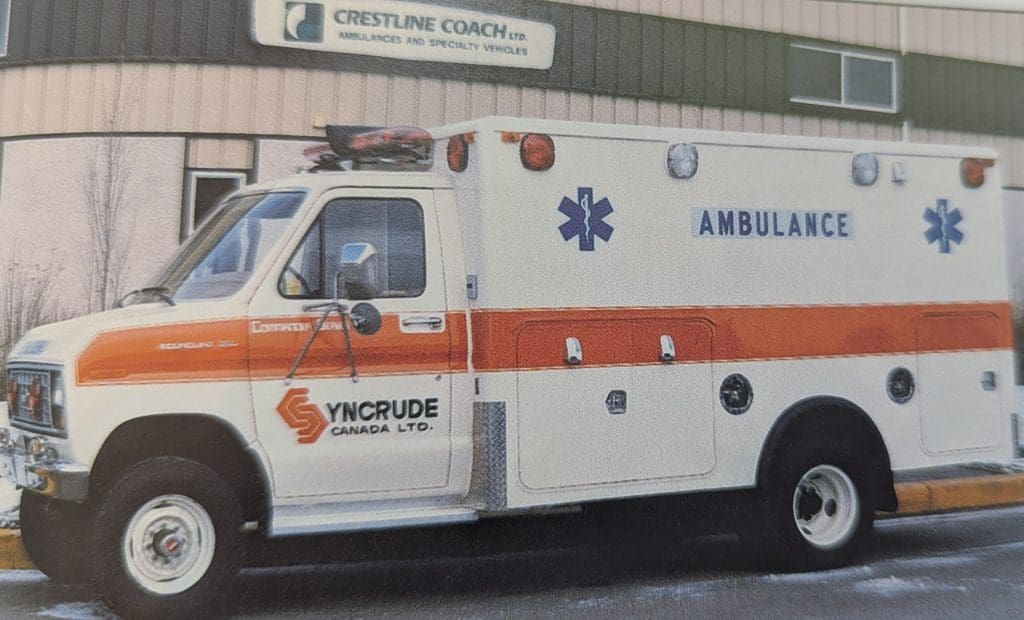
1985 – Syncrude, AB
Syncrude needed a dependable ambulance that could perform reliably in the demanding conditions of the Fort McMurray oil sands. To meet this need, Crestline delivered a 1985 Ford equipped with an aftermarket four-wheel-drive conversion, built to navigate rough terrain and extreme weather. The project strengthened Crestline’s understanding of industrial requirements and highlighted the importance of tailoring solutions to support customers working in remote and rugged environments.
1986 – Ontario Ministry of Health
This Ford unit marked an important moment as it was the first Crestline ambulance purchased by the Ontario Ministry of Health. Its provincial identification number on the front fender showed it was the 104th unit acquired by the Ministry that year. More importantly, this purchase marked the beginning of a valued and enduring partnership.
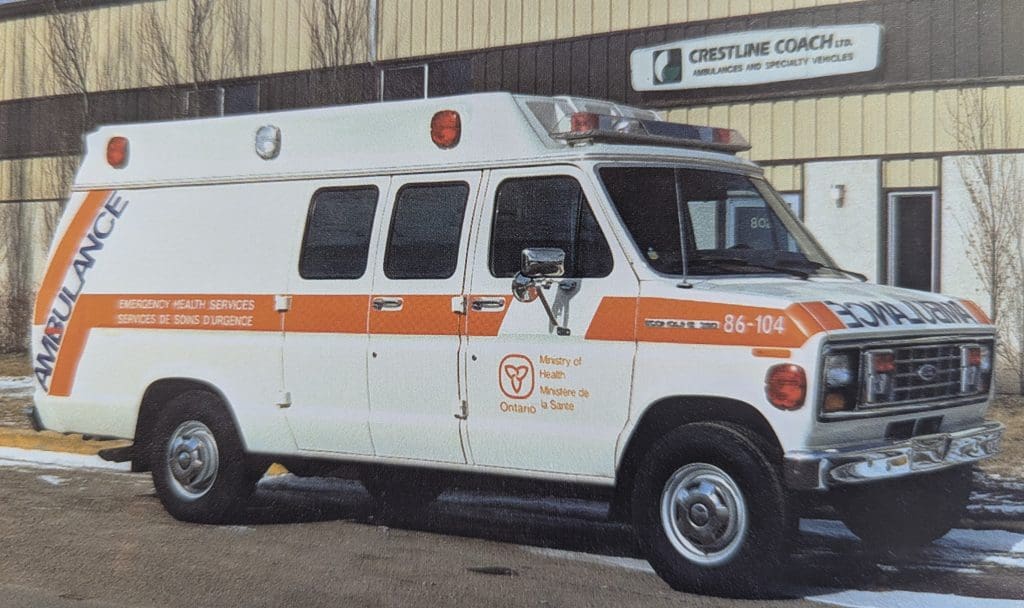

1987 – Blood Tribe, AB
Blair First Rider accepted the keys to a 1987 Crestline GM on behalf of the Blood Tribe in Standoff, Alberta. At the time, Crestline produced few GM ambulances due to design limitations. Still, the customer requested a long body GM model to meet their specific needs. Crestline responded by sourcing a standard GM van and extending the body behind the rear wheels. This project highlighted the importance of listening closely to our customers. That same approach continues to guide Crestline today, ensuring every vehicle is built to serve its fleet with purpose and precision.
1988 – Iqaluit, Nunavut
To best serve our customers in the North facing extreme cold weather, Crestline developed solutions that addressed the unique operational challenges of the region. Crestline delivered a 1988 Ford 4×4 for the community of Iqaluit, equipped with an engine and transmission heater housed in a protective enclosure. To prevent freezing, the vehicle was often left running whenever it left the garage. The experience helped Crestline better understand cold-climate requirements and design more reliable solutions for remote northern clients.


1990 – Ontario Ministry of Health
In 1990, the Ontario Ministry of Health, which operated one of the largest ambulance fleets in North America, challenged Crestline with a request. They commissioned two experimental ambulances designed to carry multiple patients for interfacility transfers between city hospitals. In response, Crestline built two long body Ford units capable of transporting four patients on stretchers or two stretchered patients with six seated, all under paramedic supervision. This project pushed Crestline to think differently about ambulance design, and we are grateful to the Ministry for encouraging innovation that continues to influence our approach today.
1991- Hanna, Alberta
Crestline introduced the Sprint XL, an extended version of the original Sprint that provided additional storage space for EMS equipment. One of the first units was delivered by Rick Reddekopp to Stan Folpel in Hanna, Alberta. Although only a small number were built, the Sprint XL helped shape future vehicle designs by setting new expectations for interior layout and storage capacity.


1992 – Dept of National Defense, Canada
Crestline was awarded a federal contract to build 23 high top Dodge ambulances for Canada’s Department of National Defense. The prototype was delivered to headquarters in Ottawa, giving Crestline the opportunity to gain valuable experience in meeting national specifications and operating requirements. This project helped strengthen Crestline’s capabilities in serving complex and large scale fleets.
1992 – Parkland Ambulance, SK
Parkland Ambulance in Prince Albert purchased Crestline’s first aerodynamically designed prototype. Originally called the Air Max, the unit featured rounded corners, a front air dam, mirror fairings, and ground effects to help reduce drag. The model was later renamed New Era. The Duchak family accepted delivery of the first unit, playing a key role in the launch of what would become one of Crestline’s most popular models.
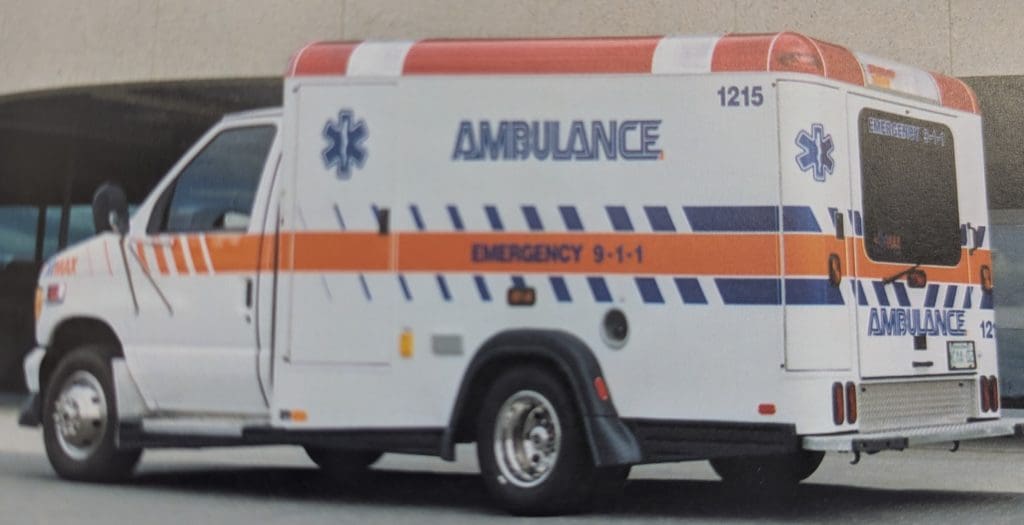
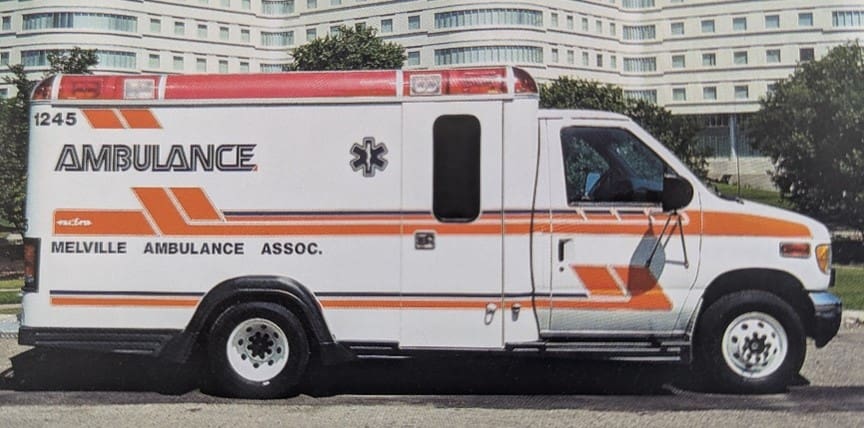
1993 – Melville, SK
Crestline’s New Era line expanded quickly as small communities such as Melville, Langenburg, Ituna, and Indian Head chose these premium ambulances for their fleets. Their investment showed that rural services placed just as much value on advanced design and performance as larger urban centers. These early adopters helped validate the importance of innovation across all regions, regardless of size.
1993 – Roadware Coporation, Ontario
Roadware Corporation in Paris, Ontario, had developed technology to assess highway conditions while driving at full speed. To support their work, they needed a professional looking vehicle with enough space to house sensitive equipment and onboard computers. After coming across a photo of Crestline’s New Era ambulance, they reached out to request a custom solution. Crestline built specialized units tailored to their needs, marking the company’s first entry into non medical transport applications and expanding its ability to serve specialized industries.


1993 – Albert Einstein Hospital, Sao Paulo, Brazil
In 1993, Crestline renewed its focus on international markets. A response to one of our advertisements came from Albert Einstein Hospital in São Paulo, Brazil. They requested a quote and soon placed an order for two New Era ambulances and one Sprint.
These units were among the most advanced Crestline had produced at the time, each equipped with nearly every available option, including the CrestRide patient air ride system. The trust we received reinforced Crestline’s commitment to supporting international customers who value the quality and capability of Canadian-built ambulances.

1995 – BC Government
For many years, the BC Government operated its own ambulance manufacturing facility. During that time, Crestline’s west coast distributor, Dynamic, focused on supporting industrial clients while gradually building a relationship with BC Ambulance Service. In 1995, the province issued a tender for 20 ambulances. Crestline was proud to supply 10 units, 1995 Ford Sprints, to their fleet. This marked the beginning of a trusted partnership that has continued to this day.
1995–1997 - Brunei
A hospital in Brunei needed a right-hand-drive ambulance. Crestline sourced a GM truck chassis, sent it to Quigley Motor Company in Pennsylvania for conversion, then completed the build in Saskatoon. The order was initiated by a Regina paramedic working overseas, proving again how relationships and reputation fuel Crestline’s global reach.


1996 – Edmonton, AB
A Crestline International Neonatal Mobile Intensive Care Unit was built for Edmonton. It featured a Ricon lift, a custom floor plan for lateral cot loading, and enough seating for a full neonatal care team. This design was shaped entirely around the customer’s request to transport both mother and newborn with complete life support.
1997 – BC Ministry of Health
The BC Ministry of Health awarded Crestline a contract for 35 New Era ambulances. To meet budget requirements, the design was adjusted by removing recessed lighting and molded interior panels. These changes, guided by the Ministry’s input, became the new standard for future New Era models, helping Crestline strike a balance between performance and cost effectiveness while continuing to meet customer expectations.

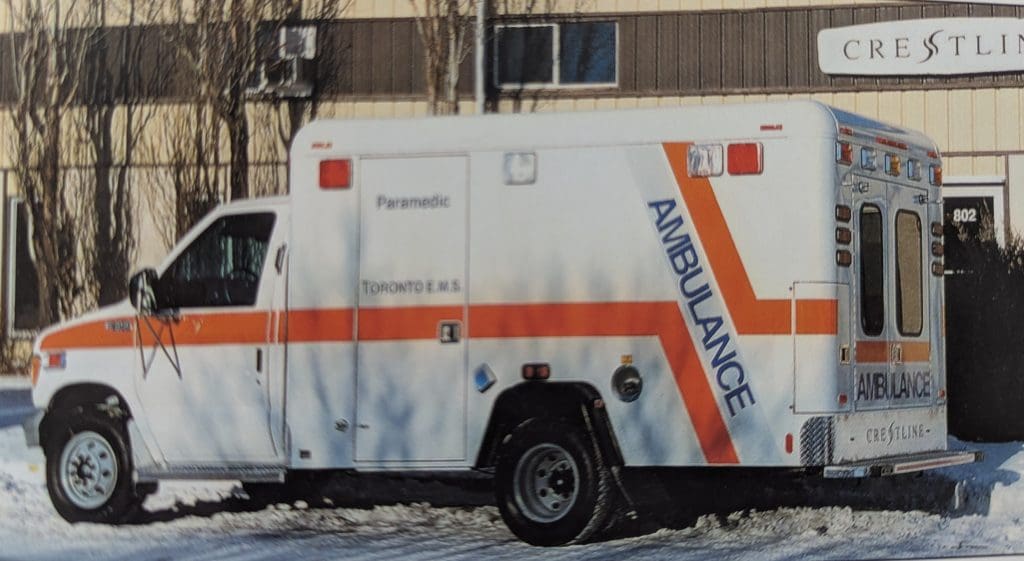
2000 – Toronto EMS, Ontario
Toronto EMS began sourcing ambulances from Crestline, starting with the delivery of fourteen New Era Ford units that year. This marked the beginning of a long-standing partnership and an opportunity for Crestline to support one of Ontario’s major municipal EMS providers.
2000 – Smoky River Ambulance, AB
The Fleetmax now enters the market as a new model featuring a full width aluminum body on a long wheelbase chassis. The first demonstrator was later purchased by Smoky River Ambulance in McLennan, Alberta. Their early support played a role in establishing Fleetmax as a key offering in Crestline’s product lineup.

2000 – Watrous, SK
A GM Fleetmax was custom built for Watrous, Saskatchewan. The customer requested a solution that would allow a patient in a wheelchair to be transported while keeping the cot in place. In response, Crestline replaced the rear facing medic seat with a folding bus seat, creating a practical and space efficient layout. This request challenged Crestline to think differently about interior design and contributed to ongoing innovation in patient transport flexibility.
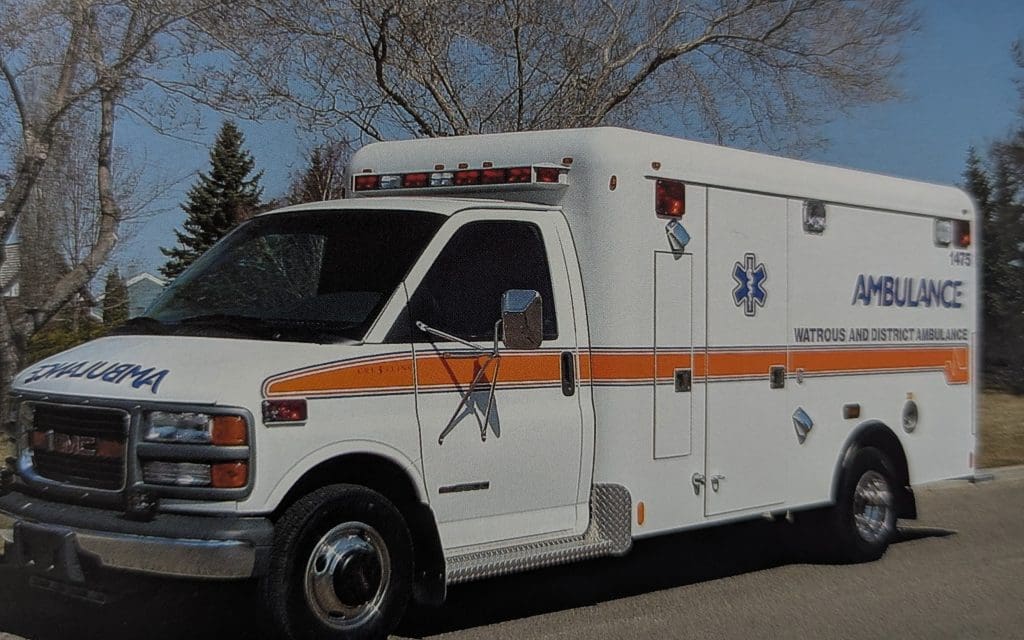


2005 – BC Ministry of Health
Crestline was proud to deliver the 500th ambulance to the BC Ministry of Health. Pictured here are Shawn Francis and Jim Fissel, the Manager of Operations.
Thunder Bay, Ontario
Superior North EMS covers a vast geographical area, which means their ambulances must perform over long distances while maintaining reliability and comfort in all conditions. To meet these demands, they rely on Crestline Fleetmax units, which are well suited for high mileage and the varied terrain of northern Ontario.
As a long-time partner, Superior North EMS has played an important role in helping Crestline better understand the needs of paramedics working in remote and demanding environments. Their feedback has directly influenced the development of new features and improvements in our designs.
One example is the integration of the CPR seat inside their Fleetmax units. This feature was designed to support effective patient care during transport and continues to provide added value for their crews. Collaborations like this help Crestline innovate with purpose and ensure our vehicles continue to evolve alongside the needs of our customers.
Toronto Paramedic Services, Ontario
Toronto Paramedic Services was a long-time New Era customer before transitioning to a remount strategy for several ambulances. Most recently, they introduced their new Fleetmax unit, marking the next phase in the evolution of their ambulance fleet. This Fleetmax includes several of Crestline’s latest upgrades, including the MCC layout and unique features tailored to their needs for 2025. Toronto Paramedic Services has been a valued partner of Crestline for many years, and we are proud to continue growing and evolving together. We were happy to deliver the prototype and will soon produce their units this summer.
Fleet Management Services (formerly VEMA), Manitoba
A long-time provincial customer, now operating under Manitoba Health, has worked closely with Crestline to develop vehicles that meet their evolving needs. Their Fleetmax units are custom designed and equipped with a mobility track seat, an eight-camera recordable system, and a fully customized lighting setup. We’re proud to continue building vehicles that fit the specific needs of our customer’s fleet.
Weeneebayko Area Health Authority (WAHA)
Weeneebayko Area Health Authority has been a long time Fleetmax customer, delivering care across remote and often challenging terrain. Serving smaller communities and rural areas, their team faces a wide range of weather conditions and relies on high quality, dependable ambulances to reach patients safely. WAHA is dedicated to providing exceptional health services rooted in the values of the communities they serve. Crestline is honoured to support WAHA in its mission and is grateful for the continued partnership.
Essex Windsor
Crestline collaborated closely with Essex Windsor EMS, who selected the Fleetmax 2.0 and requested a range of customizations to meet the specific needs of their fleet. This unit features a sliding mobility seat designed to reduce movement and increase safety during transport, along with an integrated seat belt monitoring system. Chassis cab electric coolers have been added for convenient medic access, supporting long shifts and varying response conditions. A custom lighting package improves visibility and workflow throughout the vehicle, while a dedicated drug fridge ensures secure temperature-controlled storage for critical medications.
2020 - Ottawa Paramedic Services
Crestline is proud to support Ottawa Paramedic Services with a custom 40-foot Excelsior low floor bus designed for multi-patient transport and on-scene coordination. The layout includes three stretcher positions, storable squad benches for seated patients, and a rear command post with a workstation and rest area. An on-board generator supplies power to all critical systems, ensuring reliable performance in the field. The interior features a professional finish with charcoal grey wall panels, antique white ceiling panels, and full flush-mounted windows for enhanced visibility. Privacy curtains separate the driver area and command post from the patient care space. This collaboration reflects Crestline’s ongoing commitment to delivering reliable, flexible solutions that meet the evolving needs of frontline paramedic services. Once again, we’re proud to collaborate with Ottawa Paramedic Services in delivering a dependable and adaptable vehicle that supports their paramedics and the care they provide.

2019 – U.S market
Crestline launches CCL 150 for the U.S. market, with our partners Demers-Braun Ambulances.
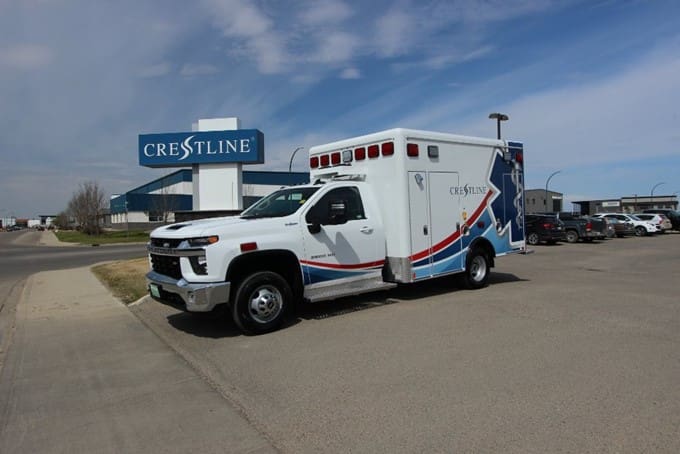
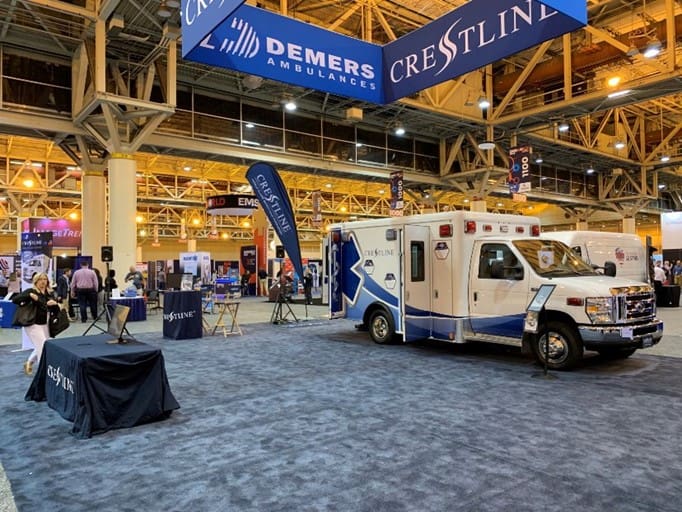
Shaped by our customers, driven by experience
Crestline’s story is defined not only by the vehicles we have built but by the people we have built them for. Every customer, from our earliest partners in Saskatoon to those across Canada and around the world, has shaped our journey and helped us become who we are today. These relationships challenged us to think differently, build better, and respond faster.
As we celebrate this anniversary, we do so with deep appreciation for the people and organizations who believed in us. Thank you for being part of our story; past, present, and future. The road ahead is exciting, and we look forward to continuing the journey with you.


